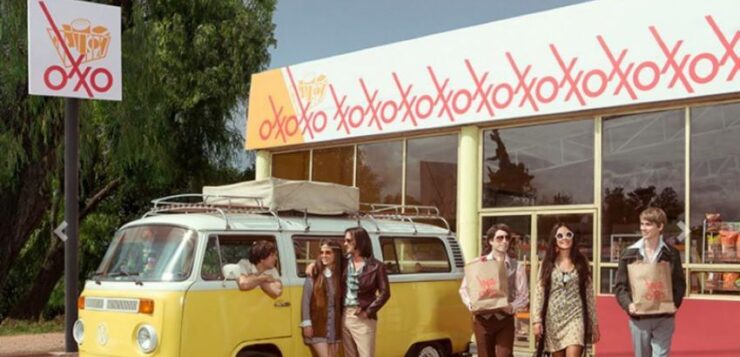The popular chain is involved in key financial aspects of customers’ daily lives
The Oxxo convenience store chain is a story of how a national brand beat out foreign ones, as well as mom-and-pop stores.
“Rumor has it if you discard your Andatti [Oxxo’s house brand of coffee] cup in a vacant lot, up will sprout a new Oxxo” says Russell Parsons of Tijuana.
Obviously, that is a joke but despite them seeming to be everywhere, more and more Oxxos do keep appearing.
The first Oxxo opened on October 16, 1978, the brainchild of Eugenio Garza Lagüera of the Cuauhtémoc Moctezuma beer company, today FEMSA. Its initial purpose was to sell the company’s beer directly to the public, along with cigarettes and snacks. Its name most likely comes from its initial “shopping cart” logo (with the O’s standing in for the wheels), but another story says it comes from the percentage sign, indicating a discount.
Within two years, there were locations in Chihuahua, Sonora and Baja California. In 1982, the company began its expansion program, recruiting Mexican families to operate new stores. These locations are not franchises but rather “mercantile commissions,” where the families become agents or “collaborators” with the company.

The stores are extremely profitable for FEMSA. They account for 40% of the income of the company, which is also the largest bottler of Coca-Cola in Latin America. As Oxxo grew and developed name recognition, it began to create its own branded products such as Andatti coffee and Bitz snack foods and even Oxxo gas. Today, it is the third most valuable brand name in Mexico, behind Corona and Telcel, with an estimated value of 44 billion pesos.
According to FEMSA’s website, Oxxos see 13.2 million customers per day at 19,556 stores, which employ over 150,000 people in Mexico. More recently, it has expanded into Chile and Colombia and even has a couple of stores in Texas. In Mexico, Oxxo dwarfs United States-based chains 7-Eleven and Circle K. Both have fewer than 2,000 stores in the nation, and neither are found in all 32 states. Circle K is something of a latecomer, but 7-Eleven México was founded two years before Oxxo.
For years, FEMSA has been opening up hundreds of Oxxos per month nonstop. However, 2020 saw the first significant decline in sales because the pandemic kept people home. By November 2020, there were only 139 new openings for the year, with 108 stores closing permanently.
Over its history, Oxxo expanded its stores’ inventory to include things such as basic staples, but beer, cigarettes, soft drinks and junk food remain the base. However, a real change came in the early 2000s, when it began providing electronic payment services, starting with buying airtime for cell phones. Today, you can do everything at an Oxxo: basic banking transactions, payment of utilities and other services, sending and receiving money, purchasing intercity bus tickets and more. These services are important in a country where many people still pay with cash and receive remittances from abroad.
But not all is rosy for the company. There are people, both foreigners and Mexicans, who at least try to avoid going into one.
One main issue is that the opening of an Oxxo puts pressure on local mom-and-pop corner stores, which often cannot compete with the chain’s ability to be open 24/7 and take debit and credit cards. A related issue is that it is owned by one of Mexico’s largest companies.

“I avoid them because they are part of the Coca-Cola monopoly here in Mexico, and I think monopolies are not good,” said Chucho Herrero of México state. “I use them only when I don’t have another option, such as when I get gas on the highway.”
Oxxo’s collaborator system has been criticized as unfair to the families who operate the stores.
There are also complaints about not being able to do electronic transactions sometimes, either because the system is down or the cashier does not have the cash available. This problem is common enough that there are popular Spanish-language memes about it on the internet — and about the cashiers being rude or unavailable.
Oxxos have also been associated with crime, blight and other social issues, even leading to restrictions against them in some communities. There have been movements to eliminate or seriously limit their presence, especially in the south.
Writer Juan Villoro wrote in a Reforma article in 2017 that Oxxos serve as a place to meet at whatever hour, even for illicit business like recruiting hitmen.
“Here in Xochimilco [in Mexico City], all Oxxos have been closed because they promote alcoholism in minors and others; also, they take away customers from traditional food stores,” said Alice Aguilar of Mexico City.

“Our [local government]decided not to allow them in Loreto,” says Baja California Sur reader Kathy Hill, “… and in their place, we have a chain of similar stores owned by a local family …”
But despite Oxxo’s problems and somewhat higher prices, it is obvious that many people love them — or at least find them very, well, convenient.
Regular users cite the hours, the electronic payments, the products not available anywhere else (like Reese’s Peanut Butter Cups) and proximity to home or work as reasons for their preference.
One thing people seem to be split on, however, is the coffee: you either love it or you hate it.
Leigh Thelmadatter arrived in Mexico 17 years ago and fell in love with the land and the culture. She publishes a blog called Creative Hands of Mexico and her first book, Mexican Cartonería: Paper, Paste and Fiesta, was published last year. Her culture blog appears regularly on Mexico News Daily.





